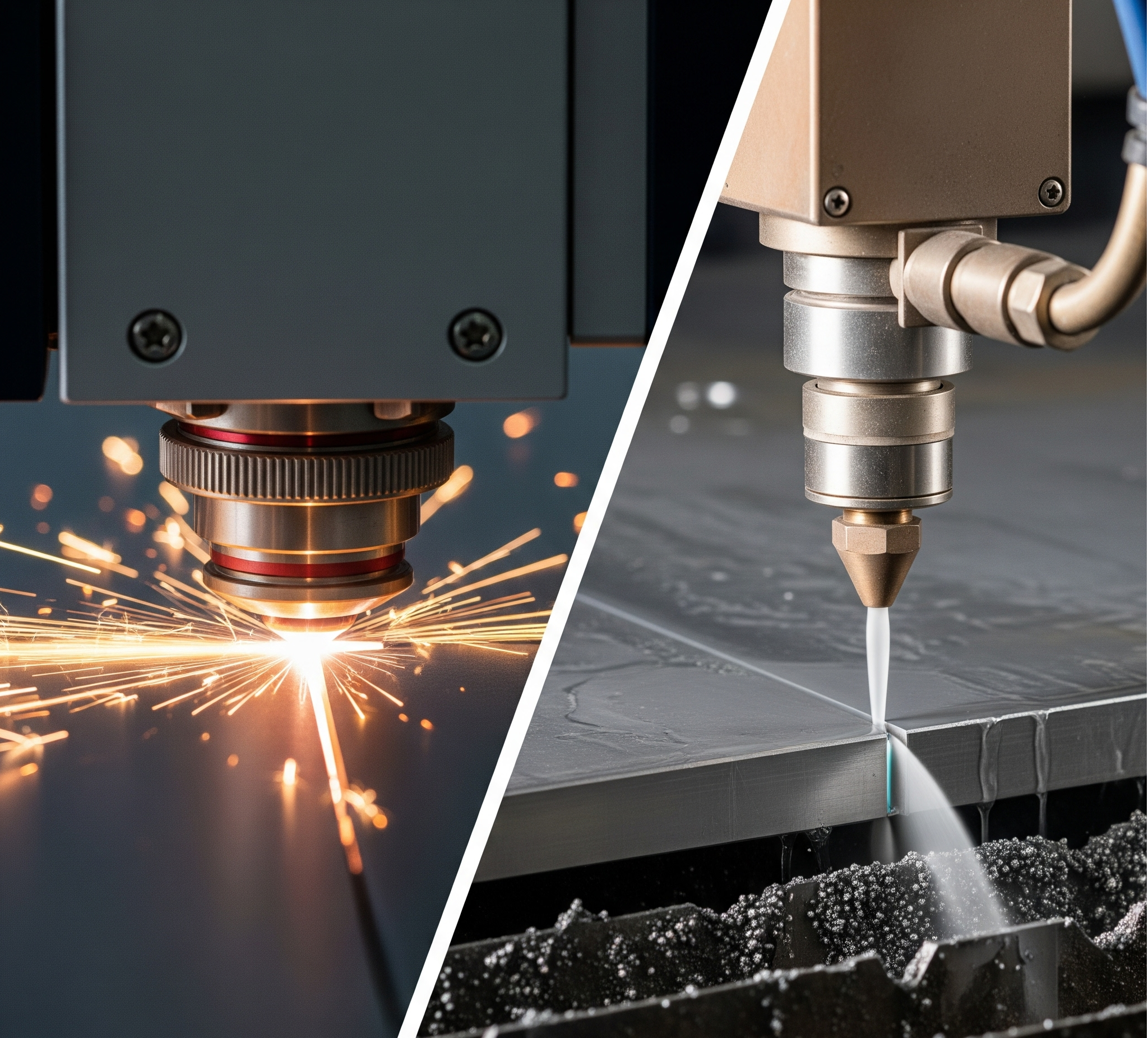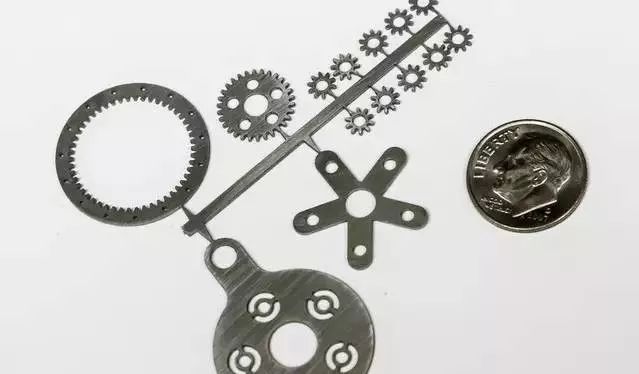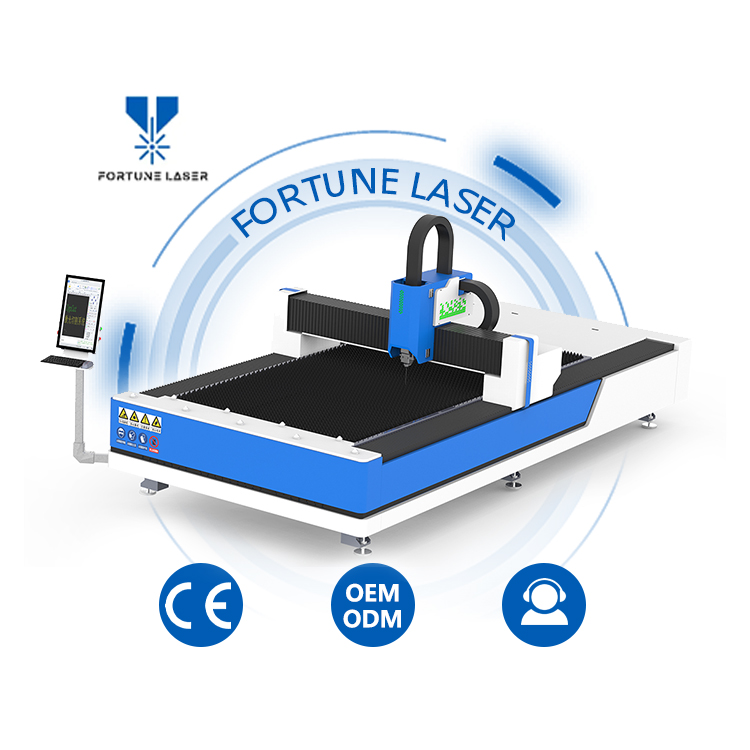In modern manufacturing, the selection of an optimal cutting process is a critical decision impacting production speed, operational cost, and final part quality. This article presents a data-driven comparison of two prominent technologies: high-power fiber laser cutting and abrasive waterjet cutting.
It analyzes key performance metrics including material compatibility, the Heat-Affected Zone (HAZ), processing speed, dimensional tolerances, and the total cost of ownership. The analysis concludes that while waterjet technology remains essential for its material versatility and “cold-cut” process, advancements in high-power fiber lasers have positioned them as the standard for high-speed, high-precision manufacturing across a growing range of materials and thicknesses.
Guiding Principles for Process Selection
The selection of a cutting process hinges on the trade-off between the thermal energy of a laser and the mechanical force of a waterjet.
Laser Cutting: This process is indicated for applications where high speed, intricate precision, and automated efficiency are primary requirements. It is exceptionally effective for metals such as steel and aluminum, as well as organic materials like acrylics, generally in thicknesses under 25mm (1 inch). High-power fiber laser technology is a cornerstone of high-volume, cost-effective manufacturing in 2025.
Waterjet Cutting: This process is the preferred solution for exceptionally thick materials (over 50mm or 2 inches) or for materials where any heat input is prohibited. Such materials include certain critical aerospace alloys, composites, and stone, where the “cold-cut” nature of the process is a mandatory engineering requirement.
Technical Comparison
The primary differences in outcomes between the two technologies are driven by their energy sources.
Expanded Technical Comparison of Fiber Laser and Abrasive Waterjet Cutting
|
Feature |
Abrasive Waterjet Cutting |
|
|
Primary Process |
Thermal (Focused Photon Energy) |
Mechanical (Supersonic Erosion) |
|
Material Compatibility |
Excellent for Metals, Good for Organics |
Near-Universal (Metals, Stone, Composites, etc.) |
|
Materials to Avoid |
PVC, Polycarbonate, Fiberglass |
Tempered Glass, Certain Brittle Ceramics |
|
Speed (1mm thick stainless steel) |
Exceptional (1000-3000 inches per minute) |
Slow (10-100 inches per minute) |
|
Kerf Width |
Extremely Fine (≈0.1mm/ 0.004″) |
Wider (≈0.75mm/ 0.03″) |
|
Tolerance |
Tighter (±0.05mm/ ±0.002″) |
Excellent (±0.13mm/ ±0.005″) |
|
Heat-Affected Zone |
Present and highly manageable |
None |
|
Edge Taper |
Minimal to None |
Present, often requires 5-axis compensation |
|
Secondary Finishing |
May require deburring |
Often eliminates secondary finishing |
|
Maintenance Focus |
Optics, Resonator, Gas Delivery |
High-Pressure Pump, Seals, Orifices |
Analysis of Critical Factors
Material and Thickness Capabilities
A primary strength of waterjet cutting is its ability to process nearly any material, a significant advantage for job shops that must adapt to diverse substrates, from granite to titanium to foam.
However, the majority of industrial applications are centered on metals and plastics, where modern laser technology is exceptionally capable. Fiber laser systems are engineered for outstanding performance on steel, stainless steel, aluminum, copper, and brass. When supplemented by CO₂ lasers, whose longer infrared wavelength is more effectively absorbed by organic materials like wood and acrylic, a laser-based workflow covers an immense range of manufacturing needs with superior speed.
Furthermore, the laser process is clean and dry, producing no abrasive sludge that requires costly handling and disposal.
Precision, Edge Finish, and Managing Imperfections
When evaluating precision and edge finish, both technologies present distinct advantages and require specific considerations.
A laser’s primary strength is its exceptional precision. Its extremely fine kerf and high positional accuracy allow for the creation of intricate patterns, sharp corners, and detailed markings that are difficult to achieve with other methods. This process does, however, create a small Heat-Affected Zone (HAZ)—a narrow boundary where the material is altered by thermal energy. For the vast majority of manufactured parts, this zone is microscopic and has no bearing on structural integrity.
Conversely, the waterjet’s “cold-cut” process is its main advantage, as it leaves the material’s structure completely unchanged by heat. This eliminates the HAZ concern entirely. The trade-off is the potential for a slight “taper,” or V-shaped angle, on the cut edge, especially in thicker materials. This mechanical imperfection can be managed, but it often necessitates the use of more complex and costly 5-axis cutting systems to ensure a perfectly perpendicular edge.
Speed and Cycle Time
The primary performance differentiator between laser and waterjet technologies is process velocity and its impact on total cycle time. For thin-gauge sheet metals, a high-power fiber laser achieves cutting speeds 10 to 20 times greater than those of a waterjet. This advantage is compounded by the superior kinematics of laser systems, which feature exceptionally high gantry acceleration and traversal speeds between cuts. Advanced methodologies like “on-the-fly” piercing further minimize non-productive periods. The aggregate effect is a drastic reduction in the time required to process complex nested layouts, leading to superior throughput and optimized cost-per-part metrics.
The Complete Cost of Ownership (CAPEX, OPEX & Maintenance)
While a waterjet system may have a lower initial capital expenditure (CAPEX), a thorough cost analysis must focus on the long-term cost of operation (OPEX). The largest single operating cost for a waterjet is the constant consumption of abrasive garnet. This recurring expense, coupled with the high electricity demand of the ultra-high-pressure pump and the significant maintenance of nozzles, seals, and orifices, accumulates rapidly. This is before considering the labor-intensive cleanup and disposal of abrasive sludge.
A modern fiber laser, in contrast, is highly efficient. Its primary consumables are electricity and assist gas. With lower day-to-day operating costs and predictable maintenance, the overall work environment is cleaner, quieter, and safer.
Discussion of Advanced Applications and Trends
In highly specialized workflows, these technologies can be complementary. A manufacturer might use a waterjet to rough-cut a thick block of Inconel (to avoid thermal stress), then transfer the part to a laser for high-precision finishing, feature creation, and part number engraving. This demonstrates that the ultimate goal in complex manufacturing is to apply the right tool for each specific task.
The advent of high-power fiber lasers has significantly shifted the landscape. These systems can now tackle thicker materials with exceptional speed and quality, providing a faster and more cost-effective alternative to waterjets in the range for many metals—a domain once exclusive to waterjets.
For rapid prototyping involving sheet metal, plastics, or wood, the speed of a laser is a distinct advantage. The ability to iterate through multiple design variations in a single afternoon enables a fast and agile product development cycle. Furthermore, the practical consideration of the workplace environment is significant. Laser cutting is a contained, relatively quiet process with integrated fume extraction, whereas waterjet cutting is an extremely loud process that often necessitates an isolated room and involves the messy management of water and abrasive sludge.
Conclusion
While waterjet cutting remains an invaluable tool for a specific set of applications defined by material sensitivity or extreme thickness, the trajectory of modern manufacturing points clearly toward the speed, efficiency, and precision of laser technology. The continuous advancements in fiber laser power, control systems, and automation are expanding its capabilities every year.
The analysis of speed, operational cost, and precision indicates that for the majority of high-volume industrial cutting applications, laser technology has become the superior choice. For businesses aiming to maximize productivity, reduce cost-per-part, and operate in a cleaner, more automated environment, a modern laser cutting system represents a strategic investment for a competitive future.
Post time: Jul-30-2025












